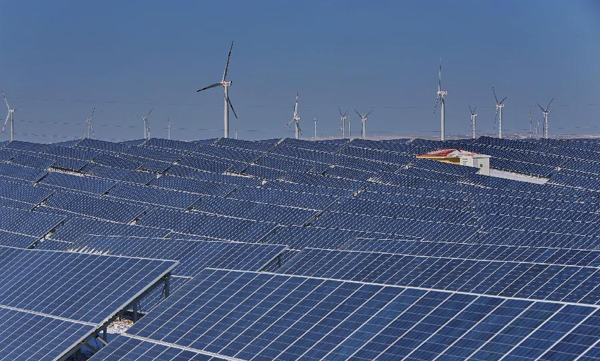China's high-tech exports face trade barriers
 0 Comment(s)
0 Comment(s) Print
Print E-mail China Daily, January 30, 2015
E-mail China Daily, January 30, 2015
|
|
|
A photovoltaic power plant and a nearby wind power farm in Zhangjiakou, North China's Hebei province,Jan 19, 2015.[Photo/Xinhua] |
Trade frictions dented exports of high-tech products and become a new concern for China and its trading partners last year, a top official said on Thursday.
Shen Danyang, a spokesman for the Ministry of Commerce, said that after China became the world's largest goods trader in 2013, many countries started to curb the import of Chinese products to narrow trade deficits
"We noticed that China's photovoltaic products, wind turbines and smartphones have encountered more trade investigations in 2014," said Shen. "The United States, Canada and Australia have all launched anti-dumping and countervailing duty investigations on Chinese photovoltaic products, an emerging change in China's foreign trade last year."
With the European Union also launching anti-dumping investigations earlier this month, Shen urged the EU to give sufficient defense opportunities to Chinese companies and review relevant data objectively.
Twenty-two countries and regions launched 97 investigations on exports of Chinese products involving $10.49 billion in 2014, including 61 anti-dumping and 14 countervailing duty investigations. The country confronted 94 trade disputes in 2013.
Zhao Ying, a researcher at the Beijing-based Institute of Industrial Economics of the Chinese Academy of Social Sciences, said: "Because China is undergoing an industrial upgrade boom, the nation is capable of exporting more high-tech or high-value added products to the global markets. But such a change has affected the market share of high-end products manufactured by developed nations."
Zhao said developed countries have no choice but to impose trade investigations on Chinese products in a bid to protect their market share in the world.
"After all, high-tech products can generate more profit when compared with garments, footwear and other low-end products that China used to manufacture overwhelmingly," Zhao said.
In addition, the trade disputes extended to hardware, food, pharmaceuticals and mining products in 2014. In the meantime, China's trading partners including the US, Canada and Australia launched 27 cases involving $2.32 billion against China's steel exports.
Sang Baichuan, director of the institute of international business at the University of International Business and Economics in Beijing, said that the value of affected exports last year "accounted for a larger share in overall exports than the average level over the past decade, showing intensified trade friction involving Chinese products".
"China will continue to face frequent trade friction and there is no reason to be optimistic about the prospects if we look at the country's international trade environment and the resurgent protectionism in the world," said Sang.
"Meanwhile, the recovery path of the global economy is proving to be more complex than anticipated. The uncertainties surrounding the economic recoveries in the US and the EU, together with concerns over employment prospects, suggest high risks of trade remedy measures against Chinese exports to protect local employment," he said.
Highlights from the briefing
1.China will over time reduce export quotas for metals to comply with a World Trade Organization ruling that these curbs are discriminatory.
2.China will urge the new Greek government to ensure Chinese companies' interests in Greece, after it halted the privatization of Piraeus port earlier this week. China believes that both governments are keen to continue to cooperate as they are close trading partners, as well as advance pragmatic cooperation in various industries to achieve progress and bring financial benefits to people in both nations.
3.China expects the Mexican government to respect international business rules and provide equal treatment to the China-Mexico joint consortium, which won the $3.75 billion high-speed rail project last November.
4. Trade with countries along the Silk Road Economic Belt and 21st Century Maritime Silk Road amounted to $1.12 trillion in 2014. Investment by Chinese companies in these countries reached $103 million in the first 11 months of last year.







Go to Forum >>0 Comment(s)